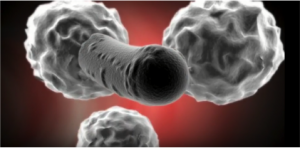

What Makes CREATIVE NANO FABRIC Facemasks to be Above The Competition

COVID-19 Related Information

Comments from use of CREATIVE COVID-19 Facemask
How to Wear Cloth Face Coverings
Cloth face coverings should--
According to Dr. Anthony Fauci, the nation's top infectious disease expert, told the public last week that going outside was fine, with cautious measures. Go out, wear a mask, stay 6 feet away from anyone so you can have the physical distancing," he told a CNN coronavirus town hall. "Go for a run. Go for a walk. Go fishing. As long as you're not in a crowd and you're not in a situation where you can physically transmit the virus."
THE HUMAN BODY USES ACTIVE INGREDIENT IN CHLORINE BLEACH TO FIGHT BACTERIA NATURALLY

A bacterium is engulfed by immune system cells in an animated frame from The Secret Life of Bleach video.
By Joan B. Rose, PhD
March 23, 2018
We live in an age in which scientists regularly reveal remarkable details of the inner workings of the human body. Recently, a group of German researchers shed new light on the composition of the “antibacterial cocktail” that our immune systems concoct to fight off infection.1 The scientists demonstrated that the active chemical in that cocktail is none other than hypochlorous acid, the active ingredient in chlorine bleach.
First Responders in the Body
A bacterium is engulfed by immune system cells in an animated frame from The Secret Life of Bleach video.Phagocytosis is the term used to describe the ingestion of a cell or cell fragment. Immune system cells in the human body are the first responders to bacterial infection, initially surrounding the pathogenic cells with a strong potion that includes hydrogen peroxide and hypochlorous acid, and then ingesting the resulting “broth.” The soaking destroys invader bacteria by chemically oxidizing them. Until the new study was published, however, it was unclear which of the components of the “cocktail” is most important to phagocytosis.
Help from Genetically Engineered Cells
The researchers used genetically engineered E. coli to track the process of bacterial destruction by oxidation. These bacteria contain fluorescent proteins that normally glow under blue light, but, when oxidized, also glow under violet light. Experiments showed glowing under violet light begins in seconds but only after the start of phagocytosis, indicating the almost immediate release of the chemical cocktail following the surrounding of bacteria by immune cells.
Two enzymes in the immune cells are critical to the production of hydrogen peroxide and hypochlorous acid for the chemical cocktail. First, enzyme #1, when activated, produces a compound that is transformed into hydrogen peroxide. Next, enzyme #2 uses that hydrogen peroxide to produce hypochlorous acid. The scientists found that cells without a working enzyme #1 (unable to produce hydrogen peroxide, and therefore, hypochlorous acid) could not oxidize invasive bacteria. Cells lacking enzyme #2 (able to produce only hydrogen peroxide) could oxidize bacteria, but not efficiently. The team used logic to deduce that hypochlorous acid is the more active ingredient in the chemical mix.
Nothing New under the Sun?
Hundreds of thousands of years before chlorine bleach was invented and used by people for laundry whitening and disinfection, the human body was producing and utilizing hypochlorous acid internally to ward off infection for millennia. This point is made clear in The Secret Life of Bleach video featuring the work of University of Michigan professor and researcher, Dr. Ursula Jakob. Dr. Jakob and her team revealed the mechanism by which bleach destroys proteins in bacteria by “unfolding” their complex, three-dimensional structures. This insight, combined with the new research, presents an even more detailed perspective on how our bodies use hypochlorous acid, a chemical product identical to the active ingredient in chlorine bleach, to fight infection and stay well.
Joan B. Rose, PhD, is the Homer Nowlin Chair in Water Research at Michigan State University, the editor of the Global Water Pathogen Project, and a member of the Water Quality & Health Council. In 2016, Dr. Rose was named the Stockholm Water Prize Laureate for her tireless contributions to global public health.
Click here to download this article.
1Degrossoli, A. et al., “Neutrophil-generated HOCl leads to non-specific thiol oxidation in phagocytized bacteria,” eLife 2018;7:e32288 DOI: 10.7554/eLife.32288. On line, available: https://elifesciences.org/articles/32288